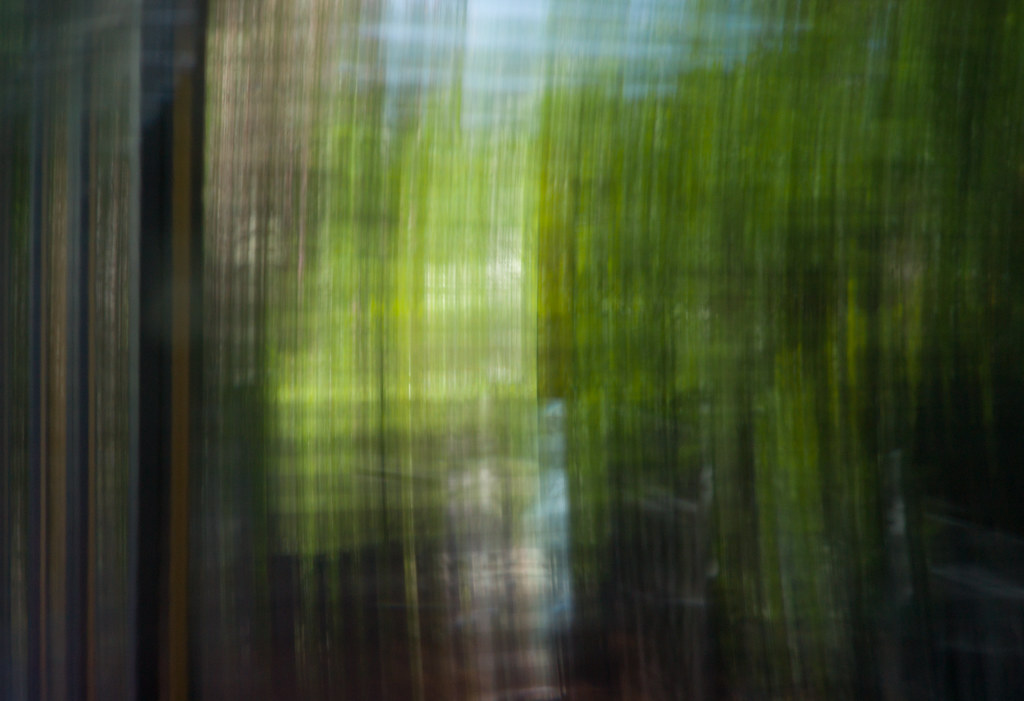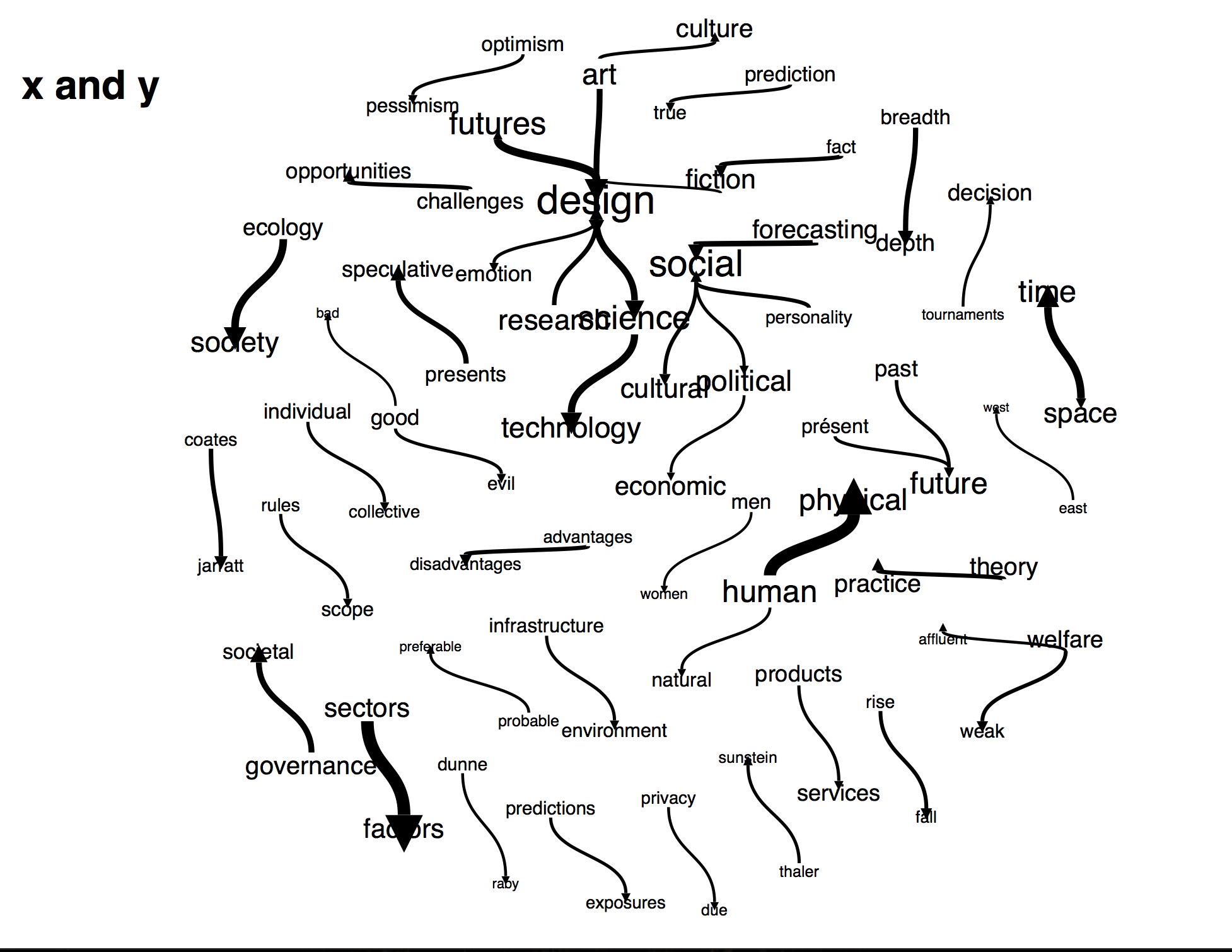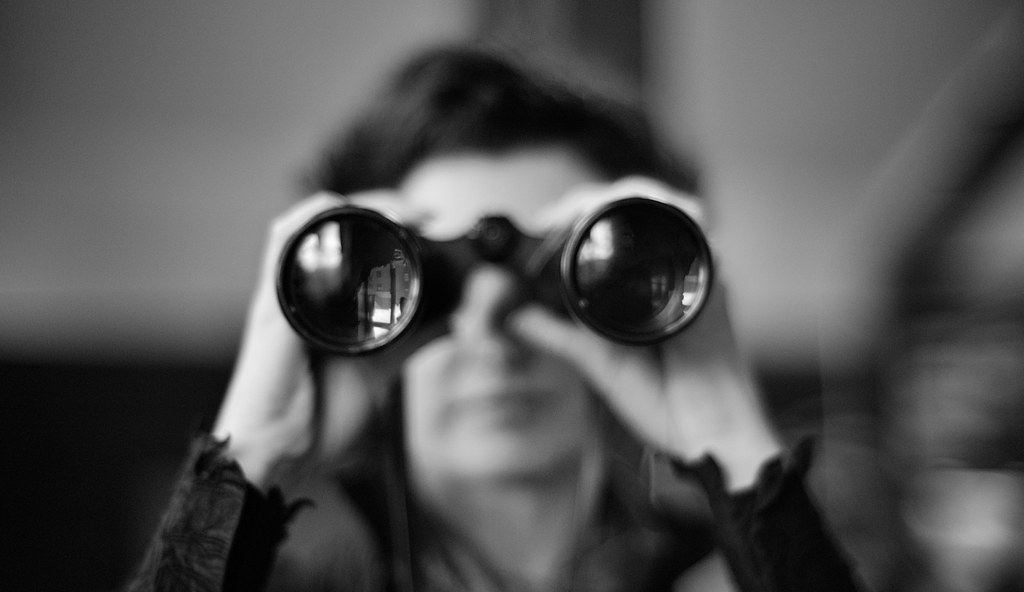Future Fabulators
This is an old revision of the document!
Musings from the Antipodean research retreat
by Maja Kuzmanovic & Nik Gaffney. Glenelg, Australia. 020140210 - 02140305
Three weeks ago, we began our research retreat in Adelaide, Australia (in line with the 'seasonal programming’ for FoAM in Brussels, despite the summer here) with the aim of better understanding the techniques, tools and theories around 'future studies' and looking further afield to find tehcniques applicable to our current work. This delineated focus was deemed necessary since it is rare for us to be able to spend time in more or less uninterrupted reading, following interesting leads down often fractal rabbit holes. We attempted to answer questions that had arisen from the last few years of practice with scenarios and in particular prehearsals.

Since we began working with what we now call 'speculative culture' (~2009), we have crossed paths with people like Bruce Sterling, Anab Jain, Chris Luebkeman, Scott Smith, Justin Pickard, Maya van Leemput, Stuart Candy (amongst others) who are more directly involved with futures, future studies or may even call themselves futurists. We have seen many points of contact (and departure) with their work, but without dedicated time to research the field in earnest we often felt like dabbling amateurs or isolated adventures, most likely been spinning the reinventing wheels and solving well understood problems. So, these few weeks have been very precious to us: we have begun to place our practice in a wider context, understand where we can stand on others' shoulders, and where we consciously or unconsciously stumbled on possible solutions or new avenues of exploration. It has helped us to more or less answer the questions of why we working more explicitly with futures, as well as beginning to glimpse answers to a few other dilemmas, including:
- how do we increase a sense of agency when faced with unknowable volatile futures?
- who are our historical and contemporary peers?
- how can we increase the commitment to co-create preferred futures?
- how can futures work empower people to live abundant, meaningful lives in the present?
- what are the different forms experiential futures can take?
- what can we add to our toolbox of methods and techniques?
- etc.

Our path towards futures
Our decision to work with futures so far has been heavily based on practice and intuition. We were frustrated with short-termism and 'thinking in silos' that has contributed to various contemporary crises. We agree with many those who see that the crisis-beneath-the-crisis is a cultural one. We saw first hand how significantly transdisciplinary co-creation help open up new possibilities. We wondered how we could increase cultural resilience in the face of turbulent unknowns and investigated how we could prepare for whatever the future might throw our way while not having to rely on predictions about what that may be. Were curious about behavioural change and visionary adaptation and found that experiencing environmental and social effects is often much more profound than preaching, showing or talking about them them. Guided by our motto “grow your own worlds”, our many paths - from mixed reality, to experience design, ecological and technological arts, process facilitation and cultural resilience - all seemed to converge on “speculative culture” or a “culture of foresight” creating a context in which we can collaboratively create diverse images of the future as embodied experiences today.
Our futures practice has a peculiar history: it evolved from a range of parallel and disparate threads in our work, some dealing with (direct) experience, others with creating our preferred futures as artistic experiments and yet others with preparing for and living in conditions of environmental, social and economic turbulence. In retrospect, we were always circling around the edges of the 'futures field', but had never explicitly researched it. To begin with, we were creating immersive, responsive environments where people could experience the effects of their actions 'on a human scale' (t* series). At the same time we worked on speculative human-plant-interactions in groWorld, as an alternative to industrial monocultures and patenting of life. Over time this work grew into an alternate reality narrative called Borrowed Scenery where we immersed our guests in a parallel reality where plants became a central aspects of human society. In another thread, we designed and hosted the transdisciplinary Luminous Green workshops to address systemic environmental and cultural challenges through participation and co-creation. And finally, the closest we came to futures studies was during Resilients, where we our field of investigation was 'future preparedness', hypothesising that we could increase personal and collective resilience by rehearsing a range of possible futures.
Our romance with the futures has always been entangled with storytelling, but also more eclectic practices including meditation, divination and invocation (which most futurists are careful to stay very clear of nowadays). Not being professional futurists, we haven't shied away from these fields - we see them as different aspects of knowing-, relating to- and having agency in the world. So, with this weird collection of conceptual and practical baggage, in the beginning of February 2014 we embarked on a journey through the unwieldy terrain of the field which calls itself “futures studies”. We had less than a month to do something that could easily have taken several PhDs (I guess we have never outgrown Alice’s plans for doing six impossible things before breakfast). Luckily, we had two very useful filters: a set of practice-based questions that we collected from various debriefs from future preparedness workshops and a more or less defined direction for the Future Fabulators pre-enactments we’re planning to design in the coming months. Whatever we researched had to be furthering our practice, in one way or another.

==== But why…? ==== We began by interviewing each other using the “5 whys” technique. From this conversation it became clear that we’re interested in examining the futures tools and techniques that can help us adapt to uncertainty (in its many guises). We believe that a culture where foresight is embedded in daily life would be more adept to living in a world of probabilities without anxiety, away from rigidly linear 'cause and effect'. Being able to envision alternative futures in the present could allow us to embrace uncertainty more easily. It could also open up new possibilities that would shake up the currently unacceptable status quo and attempt to steer it towards a future where holistic, inclusive and anti-fragile values prevail. We want to investigate experiential futurism as a way to (re)connect future visions with realities, where humans aren’t separate from planetary “others”. Our conjecture is that by experiencing what it would be like to be ourselves in a range of future scenarios we could observe our present situation more clearly, adapt to the world as it evolves and experience the agency to navigate our present in the direction of more preferred futures.

====Studying Futures====
From this rather idealistic and ambitious starting point, we delved into the literature of future studies, hoping to generate more coherent mental maps of the field. This has lead us down labyrinths of military strategy and around corporate think tanks, with pathways through dusty academic paper factories and glitzy design forecasting blogs leading us towards the future of futures and non predictive strategy. We learned buckets of jargon and came to see that futures studies has many faces and inconsistencies, as well as interesting histories and promising futures. From what we could grasp from skimming through papers and websites, the field seems somewhat fragmented and insular, comprised of various cliques, schools of thought and modes of action (which in fairness, is true of many academic disciplines with one foot in the practice-based). There are some obvious geographic and lingusitic differences; the Europeans (in France, Netherlands, Germany, UK…) and the Americans (such as RAND or the Global Business Network), some with quite formalised methods designed for policy and strategic planning originating in the (cold) war era of the 40s and 50s and more recently looking at digitally enhanced crowdsourced futures; there is the Pacific strand with the Manoa School in Hawaii and several Australian futurists enclaves, proposing methods that are perhaps more culturally and philosophically closer to what we’re interested in (such as causal layered analysis, or integral futures) and finally there are interesting futurists from Mexico, India, the middle east and parts of the Global South, with interesting views on de-colonising futures.
 ==== Scenario thinking ====
The first week of our research was preoccupied with methodology, since many of our practice oriented questions emerged from debriefs from our scenario workshops. We had planned to investigate methods from various fields suitable for scenario development and prehearsals, but due to time constraints as well as the vastly disparate literature we focused on scenario building and its methods. We had previously worked with the double uncertainty method and were curious to expand our toolbox, increase our ablility to adapt workshops to different groups and topics. After digesting several review articles comparing methods we dug deeper into those that resonated with our way of working. For example Causal Layered Analysis suggests ways to have deeper conversation about social causes, worldviews and cultural myths (with ressonances of Stuart Brand’s Pace Layers); Four Generic Futures of the Manoa School provide means for creating more 'extreme' scenarios; while Morphological Analysis looks like an interesting way to work with relationships between change drivers and resulting divergent scenarios.
Aside from these general methods, there are several specific techniques that may help us improve aspects of the scenario process. To begin with, we want to be able to ask better questions and encourage an inquiring mind, while being aware of our cognitive biases and emotions. We looked at how we could better structure a discussion about the past and present circumstances (finding interesting possibilities in the KPUU framework and integral scenario development). We looked at different ways to identify and present (interactions between) drivers of change (aka macro-trends), including horizon scanning, futures wheel, trend impact analysis or field anomaly relaxation. The question how to construct scenarios lead us deeper into the territory of axes, branches, layers, fans and cones (no specialist field is complete without a working vocabulary) - all of which can represent different relationships between (elements) of possible, probable and/or preferred futures. What we have previously called 'retrocasting' or 'scenario testing' (probing the paths from “here” to various projected futures) goes by several names, the most widespread being “backcasting” and/or “incasting”. Exploring each of these methods and techniques has of course revealed more promising leads, many of which have been left unexplored for now. However, our initial collection of scenario methods is now more extensive and has already sparked ideas about how we could use or adapt some of them in our work. We feel less constrained by the GBN method which we had become familiar with, and the limits of four scenarios based on two 'critical uncertainties'.
==== Scenario thinking ====
The first week of our research was preoccupied with methodology, since many of our practice oriented questions emerged from debriefs from our scenario workshops. We had planned to investigate methods from various fields suitable for scenario development and prehearsals, but due to time constraints as well as the vastly disparate literature we focused on scenario building and its methods. We had previously worked with the double uncertainty method and were curious to expand our toolbox, increase our ablility to adapt workshops to different groups and topics. After digesting several review articles comparing methods we dug deeper into those that resonated with our way of working. For example Causal Layered Analysis suggests ways to have deeper conversation about social causes, worldviews and cultural myths (with ressonances of Stuart Brand’s Pace Layers); Four Generic Futures of the Manoa School provide means for creating more 'extreme' scenarios; while Morphological Analysis looks like an interesting way to work with relationships between change drivers and resulting divergent scenarios.
Aside from these general methods, there are several specific techniques that may help us improve aspects of the scenario process. To begin with, we want to be able to ask better questions and encourage an inquiring mind, while being aware of our cognitive biases and emotions. We looked at how we could better structure a discussion about the past and present circumstances (finding interesting possibilities in the KPUU framework and integral scenario development). We looked at different ways to identify and present (interactions between) drivers of change (aka macro-trends), including horizon scanning, futures wheel, trend impact analysis or field anomaly relaxation. The question how to construct scenarios lead us deeper into the territory of axes, branches, layers, fans and cones (no specialist field is complete without a working vocabulary) - all of which can represent different relationships between (elements) of possible, probable and/or preferred futures. What we have previously called 'retrocasting' or 'scenario testing' (probing the paths from “here” to various projected futures) goes by several names, the most widespread being “backcasting” and/or “incasting”. Exploring each of these methods and techniques has of course revealed more promising leads, many of which have been left unexplored for now. However, our initial collection of scenario methods is now more extensive and has already sparked ideas about how we could use or adapt some of them in our work. We feel less constrained by the GBN method which we had become familiar with, and the limits of four scenarios based on two 'critical uncertainties'.

==== Experiential futures ====
As we were aproximatly knee-deep in futures research methods many of which were only partially relevant to our practice, Justin Pickard diverted our attention to Stuart Candy’s thesis “The Futures of Everyday Life”. Written in 2010, his work provides a strong theoretical and practical grounding for what he calls “experiential futures” a term that we’ll happily adopt, as it seems to fit better than say 'design fiction' or 'speculative design' for our future pre-enactments. We had a couple of inspiring conversations with Stuart and uncovered many common threads. He shares our belief in the need for diffusing foresight in daily situations, sharing tools and techniques with people beyond boardrooms and large institutions. We would happily adopt terms like 'ambient foresight' 'immersive situations' and 'guerrilla futures' to describe what we’ve been doing with alternate reality narratives and prehearsals.
Finding ourselves on more familiar transdisciplinary theory, we continued collecting references to design fiction, a field that has gained traction in recent years, merging design and foresight, to create objects, spaces and experiences as futures prototypes. Alongside (the now usual suspects) Bruce Sterling, Superflux, Dunne & Raby, The Extrapolation Factory are people and works spanning the arts, games, movies and architecture, such as Nelly Ben Hayoun, Natalie Jeremijenko, Atelier van Lieshout, Angelo Vermeulen, Adrian Hon and others. We haven’t spent too much time looking through many new and interesting projects but this is something that could benefit from further studies, conversations, comparisons, pattern-finding, etc.
Another interesting marriage of disciplines emerged as action foresight combining action research and futures studies. One of the inspiring proponents of this field is Jose Ramos, who caries out his work at the edges between futures, activism and community development. This work is particularly relevant to our inclination towards creating change in the present, as we’re still gradually formulating ideas around possible futures parallel presents and non predictive strategy. We know there are somethings there that needs surfacing, but we can’t point a finger to it yet. It has something to do with finding ways to thrive in turbulence, including strategies for antifragility, doing democracy and perhaps even a touch of rewilding etiquette. Further research and/or practice required.
All of the research related to experiential futures is at the moment geared towards prehearsing the future and improving our prehearsal pocket guide. In the three short weeks at our disposal, we haven’t got as far as we would have liked in exploring different prehearsal methods, but we think there are enough pointers that we (or anyone else interested) could pick up “later”. Next are various threads around improvisation, including various experiments from “Impro” by Keith Johnstone, and some other pointers discussed with Sarah Neville, during a follow up of her Weather Lore residency.
==== What next? ====
As our current research phase comes to an end, we can only conclude that we’re just beginning. We have left many background threads open, messy and unknotted, which is somewhat frustrating, yet we know that some of our investigations have found fertile ground. We plan to get back to the research between our practical experiments, but we’d also like to encourage all of the Future Fabulators, and anyone else interested in these subjects to keep feeding these pages with interesting, relevant and/or surprising information and insights.

